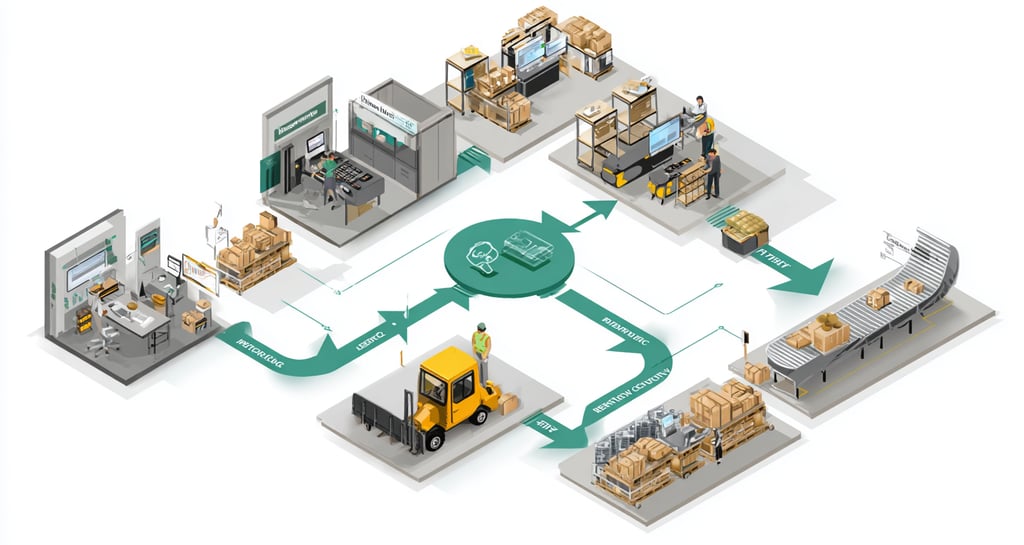E-Commerce Bookkeeping Made Simple: Sales Tax, Inventory & Platform Integration Guide
Master e-commerce bookkeeping with our complete guide covering sales tax compliance, inventory tracking, and platform integration for Shopify, Etsy, and more. Perfect for small business owners.
ECOMMERCEBOOKKEEPING
Jerry Blanco
7/17/20254 min read


Stop Wrestling with Numbers and Start Growing Your Online Business
Running an e-commerce business feels like juggling flaming torches while riding a unicycle, doesn't it? Between managing inventory, processing orders, and keeping customers happy, the last thing you want to think about is bookkeeping. But here's the reality: poor financial management is the silent killer of promising online businesses.
If you're selling on Shopify, Etsy, Amazon, or any other platform, you're dealing with unique bookkeeping challenges that brick-and-mortar businesses never face. Multi-state sales tax? Inventory tracking across platforms? Payment processor fees eating into your margins? Yeah, we get it.
The good news? You don't need an accounting degree to master e-commerce bookkeeping. With the right systems and a little know-how, you can transform this overwhelming task into a streamlined process that actually helps your business grow.
The Sales Tax Maze: Navigating Complexities Without Losing Your Mind
Let's talk about every e-commerce owner's nightmare: sales tax. Remember when you only had to worry about tax in your home state? Those days are long gone, thanks to the 2018 Supreme Court ruling in South Dakota v. Wayfair.
What This Means for Your Business
Economic nexus laws now require you to collect and remit sales tax in any state where you exceed certain thresholds—typically $100,000 in sales or 200 transactions annually. With 45 states plus D.C. having sales tax, this can get complicated fast.
Your Action Plan for Sales Tax Compliance
Track Your Sales by State Monthly
Create a simple spreadsheet with columns for each state
Record total sales and transaction counts
Most e-commerce platforms provide this data in their analytics
Monitor Nexus Thresholds
Set up alerts when you're approaching 80% of any state's threshold
This gives you time to register before you're required to collect tax
Automate Where Possible
Consider sales tax software like TaxJar, Avalara, or TaxCloud
These integrate with most e-commerce platforms and handle calculations automatically
Yes, they cost money, but the time savings and compliance protection are worth it
Keep Detailed Records
Save all sales tax returns and payments
Document your nexus analysis for each state
Store exemption certificates from wholesale customers
Pro Tip: Start tracking sales tax from day one, even if you're not required to collect it yet. Playing catch-up is expensive and stressful.
Inventory Tracking: Know What You Have and What It's Worth
Inventory is often your largest asset, but it's also where most e-commerce businesses lose money through poor tracking. Think of inventory management as the GPS for your business—without it, you're driving blind.
The Real Cost of Poor Inventory Management
Stockouts that cost you sales
Overstock that ties up cash flow
Shrinkage you can't identify
Inaccurate financial statements that mislead your decisions
Setting Up Your Inventory Tracking System
Method 1: Perpetual Inventory (Recommended) This tracks your inventory in real-time as sales happen. Most e-commerce platforms do this automatically, but you need to ensure your accounting software matches.
Method 2: Periodic Inventory You physically count everything at specific intervals. This works for smaller businesses but becomes unwieldy as you grow.
Essential Inventory Tracking Steps:
Implement a SKU System
Create unique identifiers for each product variation
Include meaningful information (size, color, style) in the SKU
Keep it consistent across all platforms
Set Up Reorder Points
Calculate your average daily sales for each product
Factor in lead times from suppliers
Set alerts when inventory hits reorder levels
Regular Physical Counts
Count fast-moving items monthly
Slow-moving items can be counted quarterly
Always count everything at year-end
Track Inventory Costs Accurately
Use either FIFO (First In, First Out) or Average Cost methods
Include shipping costs in your inventory value
Don't forget about storage and handling costs
Inventory Valuation Reality Check
Your inventory value directly impacts your profit and loss statement. Overstate it, and you'll think you're more profitable than you are. Understate it, and you might miss growth opportunities.
Platform Integration: Making Your Tools Work Together
Here's where things get interesting. You're probably using multiple platforms to sell, and each one speaks a different language when it comes to data. The key is creating a unified system that gives you the complete financial picture.
Common E-Commerce Platform Challenges:
Shopify reports gross sales, but you need net sales for accurate bookkeeping
Etsy combines your sales with their fees in confusing ways
Amazon's reports are detailed but not in accounting-friendly formats
PayPal and Stripe fees are deducted automatically, making reconciliation tricky
Your Integration Strategy
Step 1: Choose Your Accounting Software Wisely Look for software that integrates directly with your platforms:
QuickBooks Online: Great Shopify integration, decent for other platforms
Xero: Strong multi-platform support, especially for international sales
Wave: Free option with basic e-commerce features
FreshBooks: User-friendly for service-based businesses expanding to products
Step 2: Set Up Automatic Data Sync
Enable daily imports from your e-commerce platforms
Map your platform categories to your chart of accounts
Set up automatic fee categorization
Step 3: Create a Daily Reconciliation Routine
Check that imported sales match platform reports
Verify that payment processor deposits match recorded sales
Reconcile any discrepancies immediately
Real-World Integration Example:
Let's say you sell handmade jewelry on both Shopify and Etsy:
Shopify Integration: Your accounting software imports gross sales, refunds, and fees separately
Etsy Manual Entry: You download monthly statements and categorize fees, advertising costs, and net deposits
Bank Reconciliation: You match the net deposits to your bank account
Monthly Review: You compare total sales across platforms to ensure nothing's missing
The Chart of Accounts That Actually Works
Your chart of accounts is like a filing cabinet for your financial life. Here's a simple structure that works for most e-commerce businesses:
Income:
Product Sales - Shopify
Product Sales - Etsy
Product Sales - Amazon
Shipping Revenue
Sales Tax Collected
Expenses:
Cost of Goods Sold
Platform Fees (Shopify, Etsy, etc.)
Payment Processing Fees
Shipping Costs
Advertising & Marketing
Packaging Supplies
Monthly Bookkeeping Checklist: Your Step-by-Step Guide
Week 1:
Import all platform sales data
Reconcile payment processor accounts
Record inventory purchases
Categorize all expenses
Week 2:
Review and categorize any uncategorized transactions
Calculate and record cost of goods sold
Update inventory quantities and values
Prepare sales tax returns (if due)
Week 3:
Generate profit and loss statement
Review cash flow projections
Analyze best-selling products
Identify slow-moving inventory
Week 4:
Reconcile all accounts
Review financial statements for accuracy
Plan next month's inventory purchases
Prepare for quarterly tax obligations
Red Flags That Demand Immediate Attention
Watch for these warning signs in your e-commerce bookkeeping:
Decreasing gross margins: Your cost of goods sold might be creeping up
Inconsistent sales tax collection: You might be missing compliance requirements
Inventory shrinkage: Physical counts don't match your records
Unusual payment processing fees: Could indicate fraud or processing issues
Negative cash flow despite profits: Common in inventory-heavy businesses
The Bottom Line: Your Financial Success Strategy
E-commerce bookkeeping doesn't have to be the monster hiding under your business bed. With the right systems, regular maintenance, and a commitment to accuracy, you can transform this necessary evil into a competitive advantage.
Remember: good bookkeeping isn't about perfect precision—it's about having reliable information to make smart business decisions. Start with the basics, automate what you can, and don't be afraid to get help when you need it.
Your future self (and your accountant) will thank you for the solid foundation you're building today. Now stop procrastinating and start implementing these systems. Your business depends on it.


